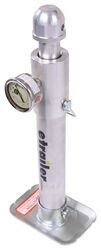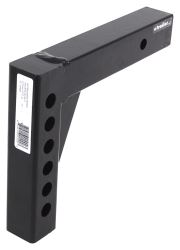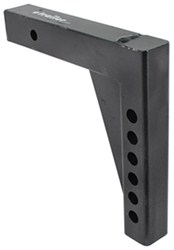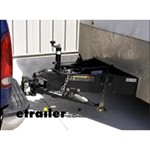
Weight Distribution Replacement Shank to Keep Hitched Trailer Level to Avoid Sway
Question:
I’m using a round bar style WD system made by Robin industries I inherited from my grandfather 800 pound bars towing a 5200 dry weight camper that’s 30’ 11” with a 2016 F-150 When I first set up my WD system the lowest I can set the ball height on my system makes it about 2.5-3” inches higher that the camper coupler height when the camper is level I’m suspecting this is what is causing my sway when driving around 60mph or with a little wind. I’m guessing my question is what is the recommend height for my ball unhooked from the camper when the camper is level ? Once I lower my camper on truck the camper is level without booking up the bars I’m thinking once I hook up the bars I’m putting too much weight on the rear axle of the camper? Any help is appreciated thanks
asked by: Tyler L
Expert Reply:
You are correct that a level trailer will be less likely to sway and keeping your hitched trailer level will enable a weight distribution (WD) system to function at its best. It is perfectly okay for a hitch ball to be an inch or so higher than the coupler on the level trailer since a little bit of normal squat will even things out but if your trailer is tipped up at the tongue when it is hitched to your F-150 you'll want to select a different shank for your WD hitch that will allow the hitched trailer to remain level.
We don't carry your brand of WD system but all those we do sell have shanks that are standardized; this means it is perfectly fine to use a Reese, Curt or Equal-i-zer shank with another brand of system. You can see all 2-inch shanks on the linked page. Since you need about 3 or 4-inches of drop for your round bar WD setup you can use a shank like # FA92-02-4213 (up to 5-1/4-inches of drop with round bars) or # FA92-02-4214 (up to 7-1/4-inches of drop with round bars).
Trailer sway will also occur if the trailer tongue weight (TW) is too low. A loaded trailer's TW should be between 10 and 15% of its gross weight. If it is too heavy at the rear (too light at the tongue) then the trailer can behave like a clock pendulum and go into back-and-forth swaying motion. Keeping the trailer TW in the right range is just a matter of careful loading and checking, using the scale # e99044.
You'll also want to note that a trailer's fully-loaded TW should fall into the middle of the WD system's operating range. All such systems work over a range of tongue weight. If your spring bars are rated for up to 800-lbs TW then they probably have an effective TW range of 400- to 800-lbs; this would mean they'd be perfect for TW of 600-lbs. As an example, a loaded trailer that weighs 6500-lbs should have a measured TW in the range of 650 to 975-lbs. If your trailer weighs this much when loaded then your bars may be under-rated if they top out at 800-lbs.
You may care to refer to the two linked articles concerning selection and installation of a WD system.

Products Referenced in This Question
etrailer Tongue Weight Scale for Campers and Utility Trailers - 2,000-lb Capacity
- Tongue Weight Scale
- Analog Scale
- 2000 lbs
- etrailer
more information >
Fastway e2 Weight Distribution Shank - 12" Long - 7-3/4" Rise, 5-1/4" Drop - 1.2K TW
- Accessories and Parts
- Weight Distribution Hitch
- Shanks
- 1500 lbs TW
- 15000 lbs GTW
- Fits 2 Inch Hitch
- e2
- Round - 5 Inch Drop
- Trunnion - 3 Inch Drop
- Round - 7 Inch Rise
- Trunnion - 7 Inch Rise
- Fastway
more information >
Fastway e2 Weight Distribution Shank - 12" Long - 10-1/4" Rise, 5-1/2" Drop - 1.2K TW
- Accessories and Parts
- Weight Distribution Hitch
- Shanks
- 1500 lbs TW
- 15000 lbs GTW
- Fits 2 Inch Hitch
- e2
- Round - 7 Inch Drop
- Trunnion - 5 Inch Drop
- Round - 10 Inch Rise
- Trunnion - 10 Inch Rise
- Fastway
more information >










